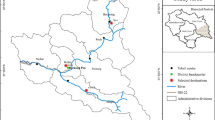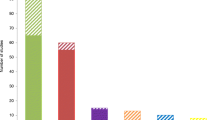Abstract
Based on the study of visitors' individual spatial behaviors, a tourists' spatial behavior simulator (TSBS) to assess the carrying capacity of tourist resorts was developed, TSBS employs GIS (Geographic Information System) to manage the spatial data, and Multi-Agent system to simulate the actions of individual visitors. By utilizing TSBS, visitors' travel patterns such as location, cost, and state can be analyzed and predicted. Based on this analysis and prediction, the model of assessing the carrying capacity of resorts is built. Our results show that TSBS will be an effective tool to accurately assess the carrying capacity of tourist resorts.
Similar content being viewed by others
References
National Bureau of Statistics of China (NBSC). The Bulletin of the Travel Information in Oct 1 Golden Week Holiday.http://www. csonline. com. cn/news/caijing/t20041009_ 245105. htm. Oct, 2004 (Ch).
Manning R.Studies in Outdoor Recreation, Corvallis: Oregon State University Press, 1999.
Mathieson A, Wall G.Tourism: Economic, Physical and Social Impacts. New York: Longman, 1982.
Fernando J G S, Yeamduan N, Daniel P M. Case study Carrying Capacity in the Tourism Industry: A Case Study of Hengistbury Head.Tourism Management, 2004,25 (2): 275–283.
Fernando J, Garrigos S, Yeamduan N,et al. Case Study Carrying Capacity in the Tourism Industry: A Case Study of Hengistbury Head. Tourism Management, 2004,25(2): 275–283.
Lawson S R, Manning R E, Valliere W A,et al. Proactive Monitoring and Adaptive Management of Social Carrying Capacity in Arches National Park: An Application of Computer Simulation Modeling.Journal of Environmental Management, 2003,68(3): 305–313.
Dai Xue-jun, Ding Deng-shan, Lin Chen. Research on Tourist Carrying Capacity of Sustainable Tourism.Human Geography, 2002,17(6): 32–36 (Ch).
Yang Rui. From Recreation Carrying Capacity to LAC Theory: On the New Development of Environmental Carrying Capacity.Tourism Tribune, 2003,18(5): 62–65 (Ch).
Wang B, Manning R. Computer Simulation Modeling for Recreation Management: A Study on Carriage Road Use in Acadia National Park, Maine, USA.Environmental Management, 1999,23(2): 193–203.
Moulin B, Chaker W, Gancet J. PADI-Simul: Agent-Based Geosimulation Software Supporting the Design of Geographic Spaces.Computers, Environment and Urban Systems, 2004,28(4): 387–420.
Zhao Hua-ci, Huang Sha-bai. Modeling and Simulation of Salvage System Based on Multi-Agent.Computer Engineering and Application, 2002,38(20): 41–43 (Ch).
Author information
Authors and Affiliations
Corresponding author
Additional information
Foundation item: Supported by the Knowledge Innovation Project of Chinese Academy of Sciences (KZCX2-SW-319-01)
Biography: ZHANG Ren-Jun (1971-), male, Ph. D candidate, research direction: application of GIS and RS.
Rights and permissions
About this article
Cite this article
Ren-jun, Z. Assessing the carrying capacity of tourist resorts: An application of tourists' spatial behavior simulator based on GIS and multi-agent system. Wuhan Univ. J. Nat. Sci. 10, 779–784 (2005). https://doi.org/10.1007/BF02830394
Received:
Issue Date:
DOI: https://doi.org/10.1007/BF02830394




